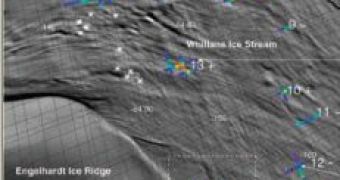Scientists had foreseen that under the huge ice sheet of Antarctica there are water reservoirs, but recent satellite imaging data took them by surprise: the water stores in much larger rivers and lakes and more quickly than thought!
Under ice rivers feed and empty huge under ice lakes in an extensive arterial system. Moreover, the lakes were found under fast-moving glaciers, thus play an important role in glacial melt speed and sea-level rises. "We've found substantial lakes under ice that's moving a couple of meters a day. It's really ripping along," says Robert Binschadler of NASA's Goddard Space Flight Center in Maryland, US.
The reservoir system was found under the Whillans and Mercer glacier, speedy ice flows that feed the largest ice shelf on the planet, the Ross Ice Shelf. "It may be that the ice streams themselves are eroding the ground beneath, making such water reservoirs more likely", said Binschadler.
Antarctica stores 90% of the world's ice and studying the behavior of these glaciers will predict how global temperature, due to human induced global warming, will affect sea-level rise. The huge under ice system of moving water could lubricate the glacier, speeding its movement from the more protected hinterland to the floating edge, where it's more exposed to melting.
In just the three years, from 2003 to 2006, Laser pulses technology employed by NASA's ICESat (Ice, Cloud, and land Elevation Satellite) mission, 600 km above the Earth's surface, found many ice areas that rose or sank under the action of under ice rivers fueling or emptying lakes beneath the ice.
The three largest subglacial lakes were over 500 square kilometers (200 square miles). Subglacial Lake Engelhardt drained into the sea two cubic kilometers of water in three years while Subglacial Lake Conway "just" 1.2 cubic kilometers. "We didn't realize that the water under these ice streams was moving in such large quantities and on such short time scales. We thought these changes took place over years and decades, but we are seeing large changes over months," said lead researcher Helen Fricker at the University of California San Diego's Scripps Institution of Oceanography in the US. "During the period studied, the team saw a net gain in subglacial water, although it is too early to draw conclusions about how this will affect the stability of the ice sheet," she said.
Drilling in the ice sheet has revealed till now the existence of more than 150 subglacial lakes but this would now be an inefficient and hard work, as the new satellite technique offers a much more comprehensive image of the ice sheet. "It is the most complete picture to date of what is going on beneath fast-flowing ice," said Bindschadler.
Image credit: Fricker et al

 14 DAY TRIAL //
14 DAY TRIAL //